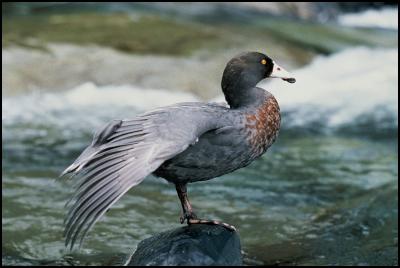Endangered ducks surveyed in Arthur’s Pass
9 February 2011
Endangered ducks surveyed in Arthur’s Pass
The whio/blue duck population in Arthur’s Pass National Park are being counted in a survey this week carried out by the Department of Conservation (DOC).
The survey, generously funded by Barry Dent of BDG Synthesis Ltd, is the first whio survey in the area for more than ten years and the first time that specialist duck-indicating dogs will be used in Arthur’s Pass National Park. The dog-handlers will be supported by DOC rangers and local volunteers.
“These unique, New Zealand ducks are found nowhere else in the world and are one of just four waterfowl species to live year-round on fast-flowing rivers,” says DOC biodiversity ranger, Malcolm Wylie.
Under the DOC and IUCN species threat classifications blue duck/whio are recorded as "Nationally Vulnerable" and "Endangered" respectively. This is due to their very small and severely fragmented population which is undergoing a rapid decline owing most notably to the affects of introduced predators. They possess little defensive capabilities and are extremely vulnerable to predation by stoats throughout their lives.

Click for big version
In response to this decline a number of private stoat-trapping initiatives have been started in the area to protect the species. In particular the Coast to Coast stoat trapping programme in the Mingha, Deception and Edwards valleys and a similar project by Arthur’s Pass resident, Gerald Bruce-Smith, in the Crow Valley, are helping to turn the fortunes of this bird around.
Malcolm Wylie, has a great deal of praise for these initiatives.
“By doing this survey we’re hoping to confirm the positive impacts of this fantastic work and also determine where trapping could be extended to help protect as many whio pairs as possible,” says Malcolm.
“The increased number of blue duck sightings the department has received over the last few years, suggest that these trapping programmes are benefitting both whio and other species in these valleys that have been devastated by stoat predation.”
“It’s great to know that the organisers of the Coast to Coast are going to expand their stoat control programme into the Upper Waimakariri later this summer – this will further help secure the whio population in Arthur’s Pass for the long-term.”
The three-day survey starts today and will cover the Mingha, Deception, Edwards, Upper Waimakariri, Bealey, Upper Otira, Crow and Hawdon valleys.
For more information on whio visit www.doc.govt.nz/whio
ENDS


 Gordon Campbell: DeepSeek, And China’s Inexorable Rise
Gordon Campbell: DeepSeek, And China’s Inexorable Rise Department Of Internal Affairs: Public Service AI Framework - Guiding Responsible Deployment Of Artificial Intelligence
Department Of Internal Affairs: Public Service AI Framework - Guiding Responsible Deployment Of Artificial Intelligence Fire and Emergency NZ: Celebrate Without Fireworks This Lunar New Year
Fire and Emergency NZ: Celebrate Without Fireworks This Lunar New Year NZ Labour Party: Luxon Misleading On The Economy
NZ Labour Party: Luxon Misleading On The Economy Dayenu: Holding Israel To Account For Genocide Takes More Than A Media Stunt
Dayenu: Holding Israel To Account For Genocide Takes More Than A Media Stunt NZCTU: 'Something Is Very Wrong In Our Society And Economy” - NZCTU Workforce Survey Shows People Fear For Future
NZCTU: 'Something Is Very Wrong In Our Society And Economy” - NZCTU Workforce Survey Shows People Fear For Future NZ Labour Party: Nicola Willis Prioritises Visitors Over Everyday Kiwis
NZ Labour Party: Nicola Willis Prioritises Visitors Over Everyday Kiwis


